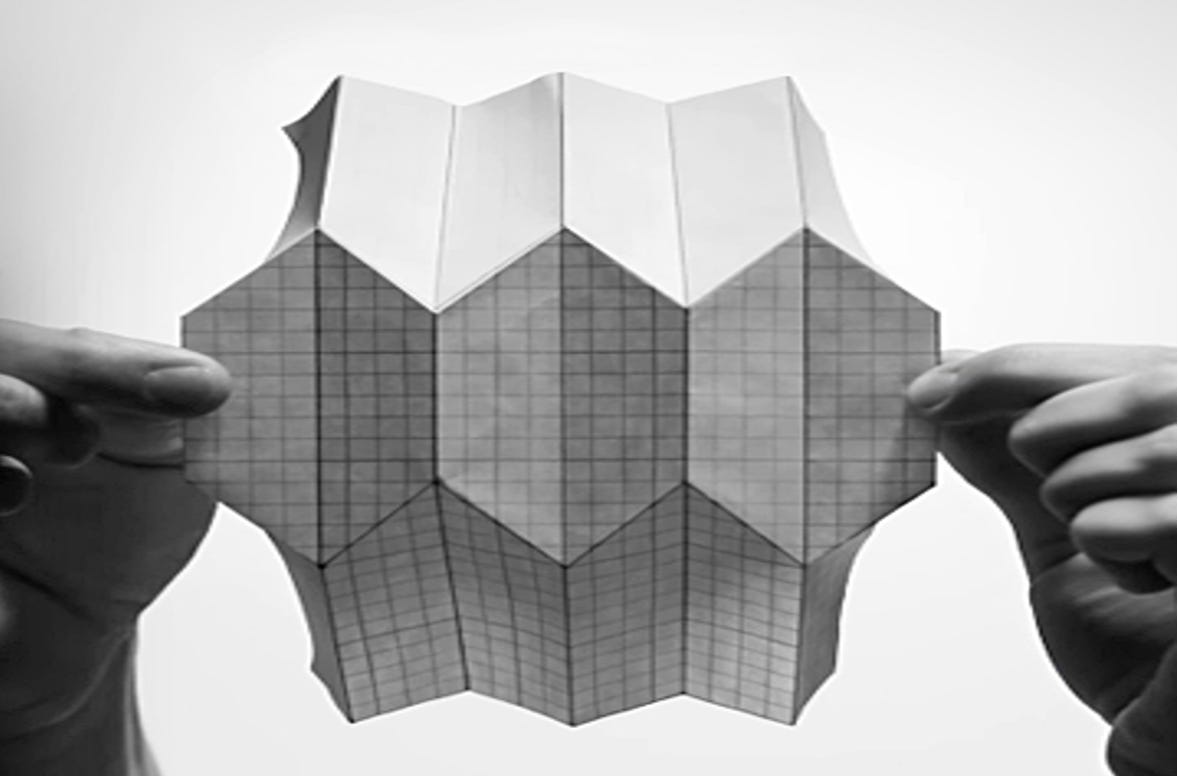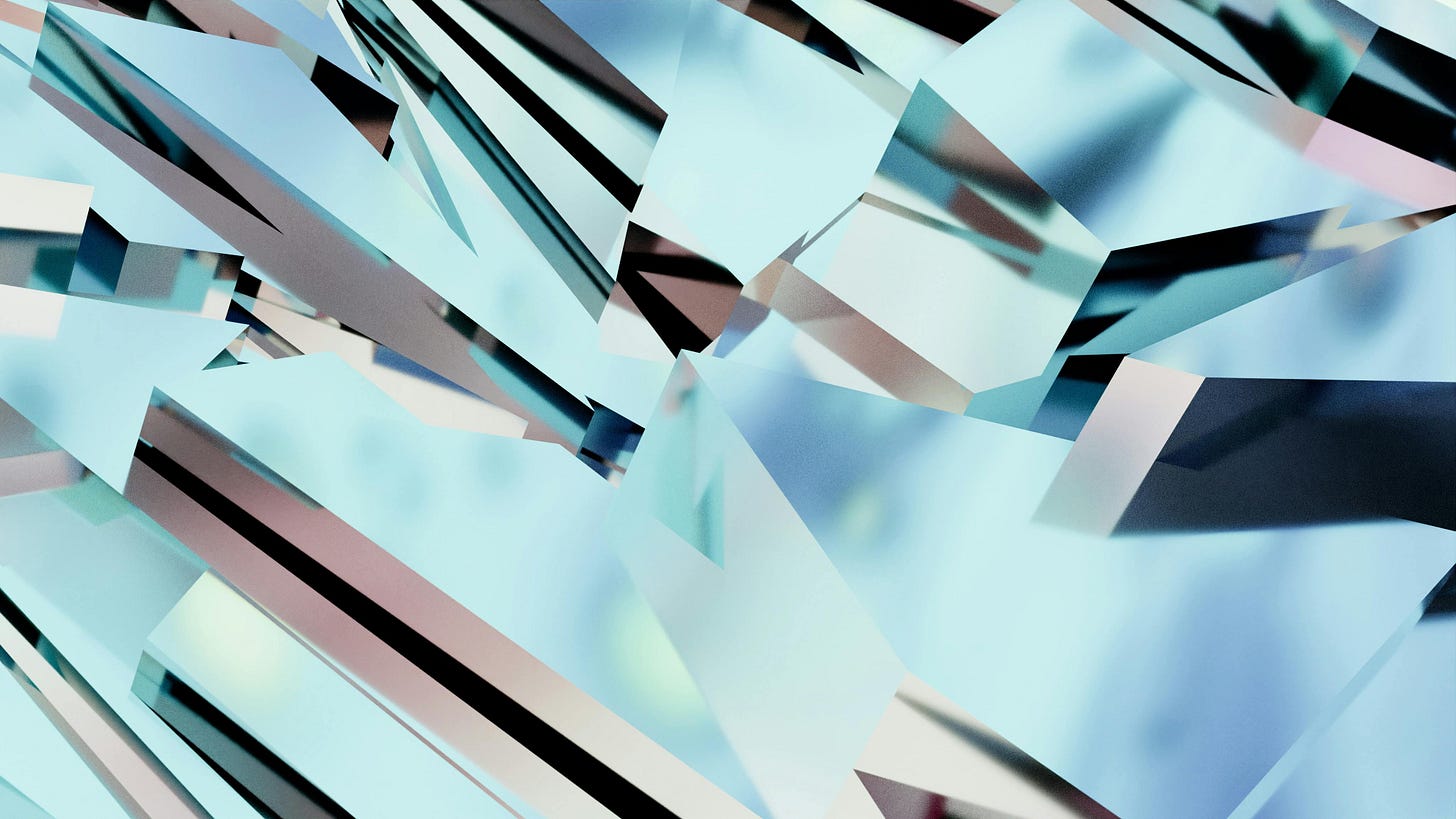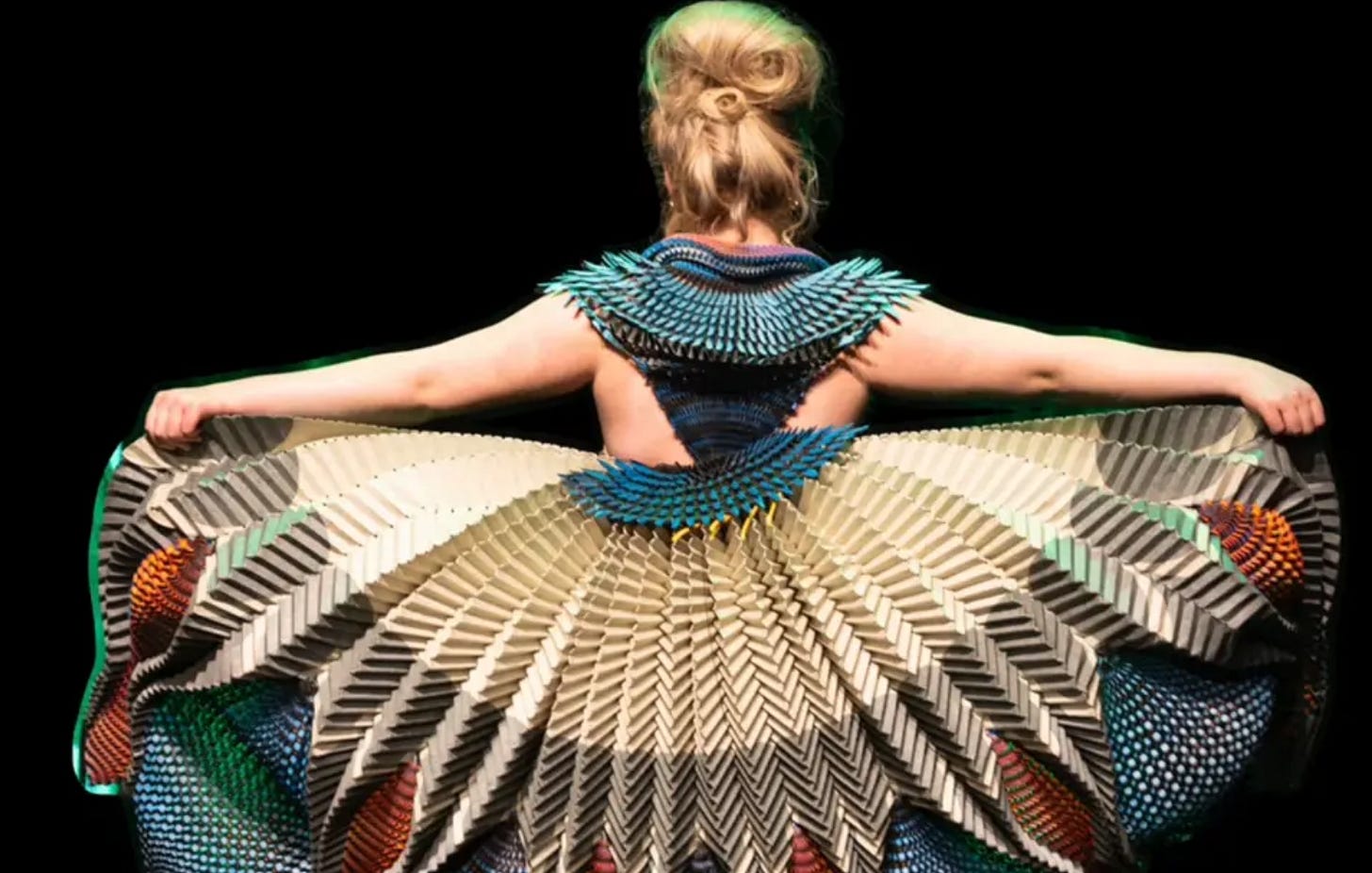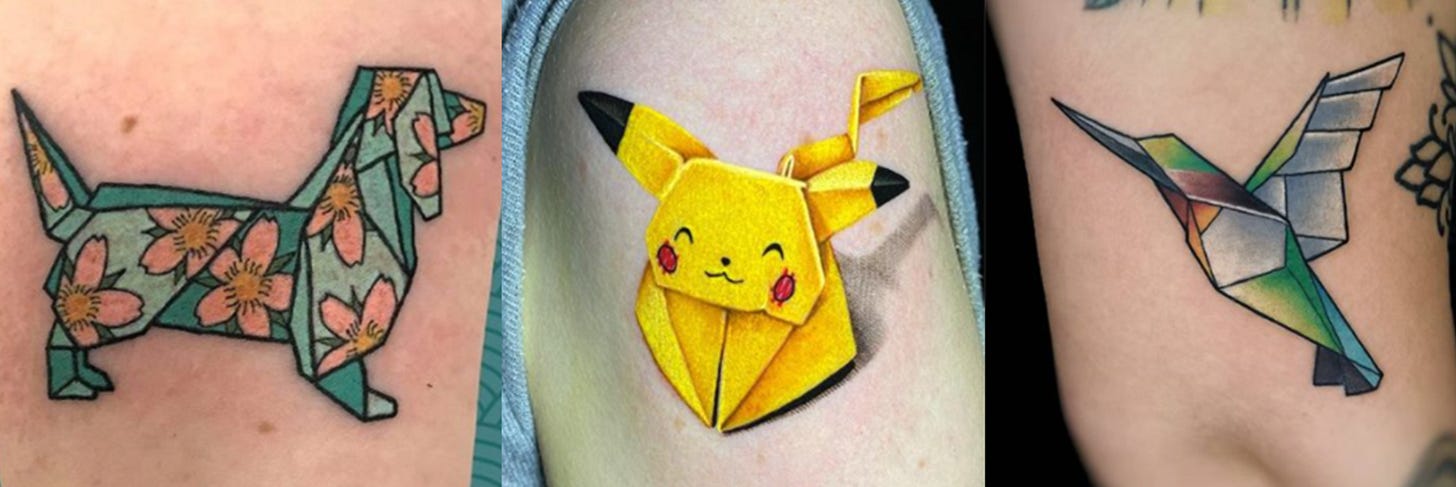🍄 The Future Is Foldable
What begins as a wrinkle in paper becomes a revolution in how we build, heal and survive.
🍄 AudioDose Alice on Sonic Mushrooms: Listen to Chasing Shadows
🎧 Alice podcasts
📘 Alice books
In the beginning, there was only a flat sheet. A blank surface, waiting. Then came the fold. Once upon a time, origami was a quiet art, passed hand to hand, across centuries and cultures, a ritual of monks, a craft for children, a symbol of grace. But today, in the thick of the 21st century, origami is no longer confined to paper swans and ceremonial fans. It is becoming one of the most consequential design languages of our time. We are unfolding a new chapter in the history of matter. Hello, we’re Alice and we are always in a state of wander.
From ancient art to atomic logic
In the labs of physicists and the imaginations of engineers, the humble fold has been elevated into a principle of physics, computation, and life itself. Take the Miura-ori, an elegant tessellation of parallelograms that collapses and expands in a single, fluid motion. Invented by an astrophysicist to solve the problem of folding maps, it was later used to launch solar panels into orbit. But in recent years, it’s been reimagined as something even more astonishing: a metamaterial. A form whose properties derive not from substance, but from structure. Push on its sides, and it responds like no banana or brick ever could, with a negative Poisson’s ratio. The more energy you inject into its folds, the more it mimics the behaviors of particles in a gas. It's not just paper, it's physics with poetic intent.
And researchers like Michael Assis are modeling origami lattices with the mathematical rigor once reserved for the atomic world. His work suggests that folds can experience phase transitions, like water freezing or steam boiling. As folds defect, reorder, and reorganize, the sheet itself undergoes a transformation, no less real than steel melting or DNA mutating.
The wrinkled universe
But not all creases are clean. Crumple a sheet, and you get chaos, or so it seems. Ian Tobasco thought otherwise. He picked up that crumpled sheet and asked: why this mess of wrinkles, and not another? His answer came through years of math and curiosity, and it revealed a hidden order within the apparent disorder. Wrinkles, he discovered, are not random, they are solutions to geometric tensions. Each ridge, a path of least resistance. Each domain, an emergent signature of the surface’s curvature. What began as a child’s curiosity became a new mathematical language, one that could help us design flexible electronics, adaptive buildings, even planetary surfaces that self-adjust.
Does form shape function? Yes! And the universe agrees.
Across biology, L. Mahadevan's, Professor of Organismic and Evolutionary Biology at Harvard, research reminds us that folding is everywhere—in brains, in petals, in insect wings. Life doesn’t build from blueprints; it bends, curves, coils. It finds function through form. Termite mounds rise like cathedral spires, not through conscious design, but through environmental feedback loops. The body folds the gut, not by drawing it out in advance, but by letting tension, motion, and need dictate its contours. Origami, it turns out, is not the exception, it’s the rule.
Folding the future: real-world origami
Today, the world’s problems are being addressed by folding what was once thought unbendable:
In aerospace labs, morphing wings now adapt mid-flight, reshaping themselves like birds in stormy skies.
At MIT, window-sized panels use origami hydrogels to pull water from desert air, no power needed.
At the nanoscale, DNA folds itself into precision drug-delivery devices, targeting superbugs with silent, folded force.
In surgery, origami micro-wipers clean laparoscopes in real-time, reducing risks and saving lives.
Ceramics, brittle, ancient, unforgiving, are now 3D-printed with origami geometry, gaining flexibility without losing strength.
In robotics, plant-inspired machines self-fold and adapt, monitoring ecosystems without wires or wheels.
Even in fashion, the runway folds back on itself, origami garments that are both wearable and architectural, rigid and fluid.
And in classrooms, especially for underserved students, origami becomes a gateway into spatial reasoning and STEM literacy.
From skyscrapers to synapses, from tattoos to tectonics, the fold has found its moment.
A crease in time
We are living in a folded reality. One where the borders between art and science, play and precision, are dissolving. A single crease in paper can now encode logic, harvest moisture, or deflect a bullet. A wrinkle in a film becomes a roadmap for material intelligence. A child’s crane becomes the blueprint for reconfigurable robotics.
This isn’t just aesthetic or abstract. It’s existential. In a world of limited space, rising temperatures, and complex needs, origami offers a path forward: compact, efficient, adaptive. It is a technology of humility, small, but powerful. Responsive, not domineering.
So the next time you fold a piece of paper,
know this: you are engaging in one of the oldest,
and newest, technologies on Earth.
You are, quite literally, shaping the future.
What else we are wandering…
🔍 Embodied Intelligence
Researchers are transforming the ancient art of origami into a design language for "smart solids"—materials that can bend, compress, and adapt like living tissue. By replacing traditional parallelogram folds with trapezoidal crease patterns, teams from Georgia Tech, the University of Michigan, and Princeton have unlocked new mechanical behaviors such as controlled shearing and symmetrical expansion. This innovation could revolutionize fields like aerospace, medicine, and athletics, enabling shape-shifting airplane wings, flexible heart stents, and adaptive running shoes—all without adding complexity. Instead, intelligence is embedded directly into the material’s structure, echoing nature’s own ability to fold, shift, and respond under pressure. (via Georgia Tech College of Sciences)
🍥 Neurodivergent Design
Darryl Bedford, a neurodivergent artist and teacher, showcased his origami and kirigami-inspired paper dresses at London Fashion Week in collaboration with designer Gareth Volka. Drawing on his dyslexia as a creative strength, Darryl began his paper art as a form of therapy and now transforms intricate folds and cuts into stunning, tactile fashion. His work, supported by the Bullock Inclusion charity, celebrates both visual beauty and sensory accessibility. (via BBC)
🖋️ Origami Tattoos
The revered Japanese art of paper folding has found new life as a tattoo motif—an elegant fusion of tradition and personal expression. (via Inked)
💻 How to Build an Origami Computer
Two mathematicians, Inna Zakharevich and Thomas Hull, have proven that origami is "Turing complete"—meaning, in theory, you could build a paper computer capable of performing any computation, just like Alan Turing’s famous machine. By encoding logical operations into intricate crease patterns and pleats, they showed how folds of paper can simulate a universal computing system. While wildly impractical for real-world tasks, their work deepens the mathematical relevance of origami, which has already inspired real-world innovations from foldable space tech to biomedical devices—demonstrating that what once seemed playful and useless now folds neatly into the future of science and engineering. (via Quanta)
🔍 Can origami made of DNA help us kill superbugs?
Dr. Ioanna Mela, chemical engineer and Royal Society University Research Fellow at the University of Cambridge, reveals how tiny DNA nanostructures are being designed to precisely target bacteria and deliver antimicrobial agents. These microscopic marvels could boost the impact of existing antibiotics and offers a new promising way to combat antibiotic resistance, a growing global health challenge. (YouTube Video of talk)
Craving more?
📘 Alice in Futureland books
🎧 Alice in Futureland podcasts
Thanks for tuning in.
For more wanderings, become an Alice in Futureland subscriber—it's free.
Invite your friends to this mad tea party and let's see how many things we can learn before breakfast.
©2025 Alice in Futureland








Awesome article... left me in awe.